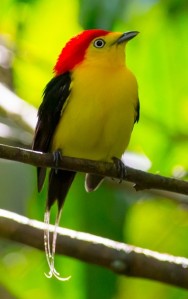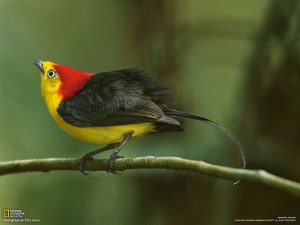 Wire-tailed Manakin (source: Wikipedia)
Wire-tailed Manakin (source: Wikipedia)
It was my birthday a few days ago, and one of the cards I received was an index card with a lovely note…and a hand-drawn wire-tailed manakin. As a scientist who studies sexual selection, I absolutely love manakins — in fact, the summer after my second year of university, I spent a month hanging out in Panama, recording the songs and dances of golden-collared manakins.
Manakins are small, colorful, frugivorous birds found in the Neotropics. (For those of you non-biologists, “frugivorous” means that they eat fruit, and “Neotropics” refer to the tropics in the Western hemisphere, i.e., Central and South America.) Manakins are known for their male secondary sexual characteristics, namely their lekking behavior. During the breeding season, male manakins will gather together at a “lek,” typically a part of the forest cleared of all debris, and start displaying — singing, dancing, making sounds with their wings, etc. Females, attracted by the noise, will sit on the edge of the lek and watch the show, eventually mating with the “best” or “best-looking” dancer/singer. Why exactly they do this is the subject of a PhD thesis rather than a blog post, so I’ll just tell you that Wire-tailed Manakins (Passeriformes: Pipridae) are found in Ecuador, Brazil, Colombia, Peru, and Venezuela, and their dances look like this.
The word “manakin” appears to come from either the Portuguese manaquin or the Dutch mannekijn (literally “little man”), but I haven’t been able to trace where those words come from. Maybe a version of a local name?
The word “wire” comes from the Old High German wiara/wiera meaning “gold or silver wire or thread.” It’s related to the Ancient Greek word ϝιρις, “wiris,” — the thing that looks like an “F” was pronounced as a /w/ and dropped out of Greek fairly early on — meaning “rainbow” or “halo,” via the Indo-European word withe, meaning “a flexible branch.”
 Nice flexible branch in many colors!
Nice flexible branch in many colors!
“Tail” we covered when we talked about the White-tailed Ptarmigan.
Pipra is, fun fact, Esperanto for “peppery,” though I seriously doubt that’s the etymology. More promisingly, it could be a declination of the Greek word πιπώ (“pipo”), which crops up in Aristotle’s History of Animals (608, apparently) and is translated to mean “a young piping bird.”
filicauda is just a translation of the English name — “fili” comes from the Latin filum meaning “thread” (“wire” would be filum metallicum, cf “filament”), and, as previously discussed, cauda means “tail.”
